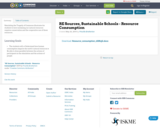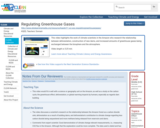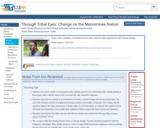
Simulating the Tragedy of Commons illustrates for students to how sustaining our natural resources requires conservation and the cooperative use of those resources.

Simulating the Tragedy of Commons illustrates for students to how sustaining our natural resources requires conservation and the cooperative use of those resources.

This video highlights the work of climate scientists in the Amazon who research the relationship between deforestation, construction of new dams, and increased amounts of greenhouse gases being exchanged between the biosphere and the atmosphere.

In this two̢ hour program, Jean Michel Cousteau and the Ocean Adventures team visit the Amazon River Basin. The mighty Amazon River flows through the world̢ĺŰĺŞs largest tropical rainforest, creating the most biodiverse area on the planet. Twenty̢ five years ago, Jean Michel explored this fabled region with his father, Jacques Cousteau. Since then, an area the size of Texas has been deforested. From this region of urgency and conflict - where human enterprise and expansion not only compromise the health and ecology of the river and rainforest basin, but also truly inflict consequences on a global scale - come new beacons of hope and sustainability.âĺ_n acest program de douĚăĺÄ ore, Jean Michel Cousteau _ĺŮi echipa Ocean Aventurile viziteazĚăĺÄ bazinul râč÷ului Amazon. Puternicul Amazon curge prin cea mai mare pĚăĺÄdure tropicalĚăĺÄ din lume, creâč÷nd cea mai mare zona de biodiversitate de pe planetĚăĺÄ. Cu douazeci ÎĺŞi cinci de ani â_n urmĚăĺÄ, Jean-Michel a explorat aceastĚăĺÄ regiune fabuloasĚăĺÄ cu tatĚăĺÄl sĚăĺÄu, Jacques Cousteau. De atunci, o zona de marimea Texasului a fost defri_ĺŮatĚăĺÄ.

This resource is a video abstract of a research paper created by Research Square on behalf of its authors. It provides a synopsis that's easy to understand, and can be used to introduce the topics it covers to students, researchers, and the general public. The video's transcript is also provided in full, with a portion provided below for preview:
"What exactly is a forest? Most people have a mental picture of what a forest is. But beyond physical appearance are values associated with what this forest provides to people and nature. Depending on your perspective, a forest may be seen as a source of timber, an ecosystem containing important biological diversity, a home for indigenous people, or a sink for carbon. A single, uniform definition of forests is unable to capture these diverse perspectives, and applying only one definition can hinder conservation, management, and restoration efforts. Yet, clear definition criteria are needed for assessing forest loss or gain at large spatial scales. To address this predicament, an international research team discusses historical forest definitions and concepts, and provides guidelines for future researchers and policy makers to navigate the complex landscapes of modern forests. The way forward, they argue, requires multiple definitions designed and applied to specific goals..."
The rest of the transcript, along with a link to the research itself, is available on the resource itself.

In this video, members of the Menominee nation discuss their experiences with climate change.

This resource is a video abstract of a research paper created by Research Square on behalf of its authors. It provides a synopsis that's easy to understand, and can be used to introduce the topics it covers to students, researchers, and the general public. The video's transcript is also provided in full, with a portion provided below for preview:
"Behind every plant is a community of microbes that support its growth, development, and evolution. Currently, these communities are in danger. Overpopulation, overconsumption, and intensive agriculture are seriously altering the plant microbiome. Signature changes include community imbalance and loss of resilience among plant microbes, and increased resistance to antibiotics, which could result in the emergence of new plant as well as human pathogens. Curbing these effects will require increased effort among microbiome scientists to understand the drivers of systemic shifts and among citizens to acknowledge and reduce their footprint on the planet..."
The rest of the transcript, along with a link to the research itself, is available on the resource itself.